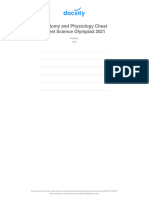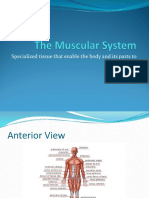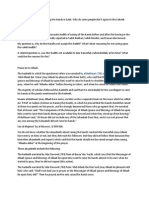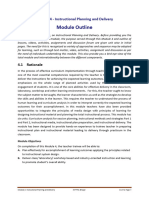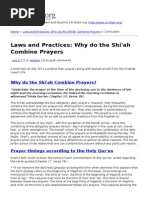Lymphatic System
Lymphatic System
Uploaded by
priya garciaCopyright:
Available Formats
Lymphatic System
Lymphatic System
Uploaded by
priya garciaOriginal Description:
Original Title
Copyright
Available Formats
Share this document
Did you find this document useful?
Is this content inappropriate?
Copyright:
Available Formats
Lymphatic System
Lymphatic System
Uploaded by
priya garciaCopyright:
Available Formats
Owned By: Pdf_sells
LYMPHATIC SYSTEM
FUNCTIONS: Lymphatic Organs
1. Fluid Balance Lymphatic Tissue – consists of many
2. Fat absorption lymphocytes and other cells, such as
3. Defense macrophages; found within lymphatic
organs
Tonsils
1. Palatine Tonsils – located on each side
of theposterior opening of the oral cavity
➢ Usually referred to as “the tonsils”
2. Pharyngeal Tonsils – located near the
internal opening of the nasal cavity
➢ Adenoid – enlarged pharyngeal
tonsil
3. Lingual Tonsil – on the posterior surface
of thetongue
ANATOMY OF THE LYMPHATIC
SYSTEM
Lymphatic Capillaries and Vessels
Lymphatic Capillaries – tiny, closed-ended
vessels consisting of
simple squamous
epithelium
Lymphatic Vessels
– resemble small
veins; formed when
lymphatic Lymph Nodes
capillaries join ➢ Rounded structures, varying from the
together; Lymph size of a small seed to that of a shelled
consists of excess almond
tissue fluid and
Cortez (outer part) – contains follicles
plasma proteins
carried by (collection of lymphocytes); germinal centers
lymphatic vessels enlarge when antibodies are released by
plasma cells
Right Lymphatic Medulla (inner part) – contains phagocytic
Duct – lymphatic vessels from the right
macrophages
upper limb and the right half of the head,
neck and chest; empties into the right Capsule – dense CT that surrounds each
subclavian vein lymph node
Thoracic Duct – lymphatic vessels from the Trabeculae – extensions of the capsule
rest of the body; empties into the left Lymphatic Nodules – dense aggregations of
subclavian vein tissueform from lymphocytes and other cells
Lymphatic Sinuses – spaces between the
lymphatictissues that contain macrophages on
a network of fibers
Germinal Centers – lymphatic nodules
containing the rapidly dividing lymphocytes
Owned By: Pdf_sells
OVERVIEW OF THE LYMPHATIC SYSTEM
Flow of lymph through nodes ➢ The lymphatic system removes fluid from
• Lymph enters the convex side through tissues, absorbs fats from the small intestine,
afferent lymphatic vessels and produces B cells and T cells, which are
• Lymph flows through a number of
responsible for much of immunity.
sinuses inside the node
• Lymph exits through efferent lymphatic IMMUNITY
vessels ➢ The ability to resist damage from foreign
• Because there are fewer efferent than substances – such as microorganisms,
afferent vessels, flow is slowed harmful chemicals, and internal threats
Spleen Innate Immunity – nonspecific resistance; the
➢ Roughly the size of a clenched fist and body recognizes and destroys certain foreign
is located in the left, superior corner of substances, but the response to them is the
the abdominal cavity same each time the body is exposed.
➢ Has an outer capsule of dense CT and Adaptive Immunity – specific immunity; the
a small amount of smooth muscles body recognizes and destroys certain foreign
Trabeculae – divide the spleen into small, substances, but the response to them improves
interconnected compartments containing 2 each time the foreign substance is
specialized types of lymphatic tissue encountered.
White Pulp – surrounds the arteries within ➢ Specificity – ability of adaptive
the spleen immunity to recognize a particular
Red Pulp – associated with the veins substance
➢ Memory – ability of the adaptive
immunity to “remember” previous
encounters with a particular substance
INNATE IMMUNITY PHYSICAL
Barriers
➢ Prevent microorganisms and chemicals
Thymus from entering the body in two ways:
➢ Bilobed gland roughly triangular in shape 1. Skin and mucous membranes form
➢ Site for maturation of lymphocytes barriers that prevent their entry
Capsule – thin CT that surrounds each lobe 2. Tears, saliva, and urine wash these
Trabeculae – divide each lobe into lobules substances from body surfaces
Cortex – dark-staining areas where
lymphocytes are numerous
Medulla – lighter-staining, central portion of
the lobules; has fewer lymphocytes
Owned By: Pdf_sells
Chemical Mediators throughout the body
➢ Are molecules responsible for many ➢ SYMPTOMS: increase in neutrophil
aspects of innate immunity numbers, fever, and shock.
Complement – group of approximately 20 ➢ PYROGENS – stimulate fever production
proteins found in plasma ADAPTIVE IMMUNITY
Interferons – are proteins that protect the body Antigens – substances that stimulate adaptive
against viral infections immune responses
White Blood Cells 1. Foreign Antigens – introduced from
➢ Most important cellular components of outside
immunity the body (Ex: bacteria, viruses, chemicals
➢ Important chemicals known to released by microorganisms)
attract WBC: Complement, ➢ Allergic Reaction – caused by foreign
Leukotrienes, Kinins, Histamine antigens that produce an overreaction
Chemotaxis – movement of WBC toward these of the immune system
chemicals 2. Self-Antigens – molecules of the body
Phagocytic Cells produces to stimulate and immune system
Phagocytosis – the ingestion and destruction of response
particles by cells called phagocytes ➢ Autoimmune Disease – results when
Neutrophils – small phagocytic cells that are self- antigens stimulate unwanted
usually the first cells to enter infected tissues destruction of normal tissue
• PUS – accumulation of fluid, dead
neutrophils, and other cells at a site of
infection
Macrophages – monocytes that leave the blood,
enter tissues, and enlarge about fivefold
Mononuclear Phagocytic System –
phagocytes ith a single (mono), unlobed nucleus
➢ Dust cells – macrophages in the lungs
➢ Kupffer cells – liver
➢ Microglia – central nervous system
Cells Of Inflammation
BASOPHILS – motile WBCs that can leave the
blood and enter infected tissues
Mast Cells – nonmotile cells in CT, esp. near Antibody-Mediated Immunity
capillaries • involves proteins called antibodies, which
Eosinophils – produced in red bone marrow; are found in the plasma
enter the blood, and within a few minutes enter B CELLS – lymphocyte that produces antibodies
tissues Cell-Mediated Immunity
Natural Killer cells • involves the actions of a second type of
➢ Type of lymphocyte produced in RBM, lymphocyte, called T cells
account up to 15% of lymphocytes CYTOTOXIC T CELLS – lyse virus-infected
➢ Recognize classes of cells, such as tumor cells, tumor cells, and tissue transplants
cells or virus-infected cells in general; ➢ CYTOKINES – promote inflammation
causes these cells to lyse and phagocytosis
Inflammatory Response HELPER T CELLS – inhibit the activities of both
Local Inflammation – confined to a specific area AMI and CMI
of the body
➢ SYMPTOMS: redness, heat, swelling,
pain, and loss of function
Systemic Inflammation – generally distributed
Owned By: Pdf_sells
Origin And Development Of Lymphocytes Antibody Production
Stem Cells – Primary Response – results from the first
Give rise to all exposure of a B cell to an antigen
the blood cells Plasma Cells – produce antibodies
Clones – small Memory B Cells – responsible of the secondary
groups of response
identical B cells Secondary Response / Memory Response –
or T cells that occurs when the immune system is exposed to
are form during an antigen against which it has already
embryonic produced a primary response
development
Activation And Multiplication Of
Lymphocytes
Antigen Recognition
Antigen Receptors – proteins of the
lymphocytes
➢ B-CELL RECEPTORS – antigen receptors
on B cells
➢ T-CELL RECEPTORS – antigen receptors
on T cells
Major Histo Compatibility Complex (Mhc)
Molecules – are glycoproteins that have binding
sites for antigens
Costimulation – achieved by cytokines Cell – Mediated Immunity
(regulator of neighboring cells) ➢ A function of cytotoxic T cells and is most
➢ Interleukin-1 – is a cytokine released by effective against microorganisms inside
macrophages that can stimulate helper T body cells
cells Acquired Immunity Active Natural Immunity
Lymphocyte Proliferation ➢ Results from natural exposure to an
Interleukin-2 – binds to interleukin-2 antigen
receptors and stimulates the helper T cells to Active Artificial Immunity
divide ➢ An antigen is deliberately introduced into
B Cell Proliferation – when helper T cells an individual to stimulate the immune
stimulate B cells to divide and differentiate into system
cells that produce antibodies ➢ Vaccination // Vaccine (antigen
Antibody-Mediated Immunity Structures Of introduced)
Antibodies
Antibodies – proteins produced in response to
an antigen
Variable Region – part of the antibody that
combines with the antigen
Constant Region – the rest of the antibody
Gamma Globulins – other name for antibodies
Immunoglobulins (Ig) – part of the plasma
where antibodies and found Passive Natural Immunity
Effects Of Antibodies ➢ Results hen antibodies are transferred from
➢ Directly inactivate antigens or cause them a mother to a child across the placenta
to clump together before birth
➢ Indirectly destroy antigens by
promoting phagocytosis and inflammation
You might also like
- Kevin Trudeau's Mega MemoryDocument368 pagesKevin Trudeau's Mega Memorynosz94% (49)
- Intermediate Plus End of Course Test (Units 1-8) : ListeningDocument6 pagesIntermediate Plus End of Course Test (Units 1-8) : ListeningАнжелика Шаповалова100% (1)
- Body CavitiesDocument10 pagesBody CavitiesGoutam ChandraNo ratings yet
- NUR 3032 Immune System Study PlanDocument5 pagesNUR 3032 Immune System Study PlanThalia Fortune100% (1)
- Chapter 2 - The American Colonies EmergeDocument23 pagesChapter 2 - The American Colonies Emergeapi-233545455No ratings yet
- Kuhnle-2012-The Emergence of The Western Welfare StateDocument20 pagesKuhnle-2012-The Emergence of The Western Welfare StateBorsFasoleNo ratings yet
- Pun Ngai - Made in China - Women Factory Workers in A Global Workplace (2005) PDFDocument233 pagesPun Ngai - Made in China - Women Factory Workers in A Global Workplace (2005) PDFIleana Cosanzeana100% (1)
- Muscular - System McgrawhillDocument60 pagesMuscular - System Mcgrawhillkhara teanoNo ratings yet
- The Lymphatic System and Body DefensesDocument12 pagesThe Lymphatic System and Body DefensesGuenevere DamasinNo ratings yet
- CHAPTER 1. Anatomy and Physiology OverviewDocument11 pagesCHAPTER 1. Anatomy and Physiology Overviewwella wella100% (2)
- Chapter 12 Lymphatic SystemDocument70 pagesChapter 12 Lymphatic SystemCharlz Zipagan83% (6)
- 3.3 GIT Physiology Part 1 VilaDocument32 pages3.3 GIT Physiology Part 1 VilaMonica100% (1)
- Docsity Anatomy and Physiology Cheat Sheet Science Olympiad 2021Document3 pagesDocsity Anatomy and Physiology Cheat Sheet Science Olympiad 2021venkatpotula06100% (2)
- The Skeletal SystemDocument4 pagesThe Skeletal SystemJoya Sugue AlforqueNo ratings yet
- Lymphatic SystemDocument10 pagesLymphatic SystemPasipanodya MuzendaNo ratings yet
- Chapter 7 - NERVOUS SYSTEM PDFDocument58 pagesChapter 7 - NERVOUS SYSTEM PDFMary LimlinganNo ratings yet
- Integumentary SystemDocument39 pagesIntegumentary SystemJam Knows Right100% (5)
- Introduction of Anatomy PDFDocument34 pagesIntroduction of Anatomy PDFUohna MoienNo ratings yet
- ANATOMY: Muscular System Quiz Study Guide Part 1Document4 pagesANATOMY: Muscular System Quiz Study Guide Part 1jbradeeNo ratings yet
- The Muscular System: Powerpoint Lecture SlidesDocument130 pagesThe Muscular System: Powerpoint Lecture SlidesTricia Mae CorpuzNo ratings yet
- Tissues: Tissue: A Tissue Is A Collection of Cells Having Similar Origin, Structure, and FunctionDocument13 pagesTissues: Tissue: A Tissue Is A Collection of Cells Having Similar Origin, Structure, and Functionnagahushanam100% (1)
- The Lymphatic System and Lymphoid Organs and TissuesDocument46 pagesThe Lymphatic System and Lymphoid Organs and Tissuessanananaa100% (1)
- Overview of Anatomical PositionsDocument8 pagesOverview of Anatomical Positionsmarcus colgrove0% (1)
- Bone Joint Cartilage PowerpointDocument81 pagesBone Joint Cartilage PowerpointChevie Wiseman100% (2)
- Tissue Anatomy and PhysiologyDocument35 pagesTissue Anatomy and Physiologysnp88100% (1)
- 2.1 (B) - Role of Muscles, Ligaments & Tendons inDocument19 pages2.1 (B) - Role of Muscles, Ligaments & Tendons inliefeng81100% (1)
- Sheep Brain Observation LAB 2015Document4 pagesSheep Brain Observation LAB 2015Leo MatsuokaNo ratings yet
- Human Anatomy and PhysiologyDocument46 pagesHuman Anatomy and PhysiologyBegumHazin100% (1)
- Spinal NervesDocument15 pagesSpinal NervesPrachNo ratings yet
- ANP 1105 The Lymphatic SystemDocument23 pagesANP 1105 The Lymphatic SystemMathios Tigeros100% (1)
- Chapter 7 Muscles Power PointDocument102 pagesChapter 7 Muscles Power PointNurseReyesNo ratings yet
- Support Systems in AnimalsDocument17 pagesSupport Systems in AnimalsYong LingNo ratings yet
- Chapter 1 AnaPhy Notes - ReviewerDocument6 pagesChapter 1 AnaPhy Notes - ReviewerDanielle LeighNo ratings yet
- Epithelial TissueDocument11 pagesEpithelial TissueFadhil Hussam Ahmed100% (1)
- Exam A-3Document11 pagesExam A-3yapues87No ratings yet
- Anatomy - Physiology (Chapter 7 - Muscular System)Document39 pagesAnatomy - Physiology (Chapter 7 - Muscular System)Kaireen OzNo ratings yet
- CU 1 Human Anatomy & PhysiologyDocument42 pagesCU 1 Human Anatomy & Physiologycheez spinach100% (5)
- Histology of The Nervous System 2011Document33 pagesHistology of The Nervous System 2011Ng Bing JueNo ratings yet
- Physiology of Digestive SystemDocument70 pagesPhysiology of Digestive SystemVincent SerNo ratings yet
- Anatomy and PhysiologyDocument11 pagesAnatomy and PhysiologyFiona Aaronica Hope Libranda100% (1)
- Quiz On Muscular SystemDocument1 pageQuiz On Muscular SystemBeverly BagayaoNo ratings yet
- Specialized Tissue That Enable The Body and Its Parts To MoveDocument23 pagesSpecialized Tissue That Enable The Body and Its Parts To MoveJJ Almagro100% (2)
- 8 Bone TissueDocument39 pages8 Bone Tissuevanderphys100% (1)
- The Muscular System NewDocument11 pagesThe Muscular System Newapi-338929411No ratings yet
- Muscular System OutlineDocument6 pagesMuscular System Outlineapi-294104473No ratings yet
- Human Digestive SystemDocument11 pagesHuman Digestive SystemSyeda NafeezaNo ratings yet
- Skeletal SystemDocument19 pagesSkeletal Systemsmbdy tbhhhNo ratings yet
- Anatomy Lymphatic SystemDocument46 pagesAnatomy Lymphatic SystemJenise MuLatto Franklin100% (2)
- The Nervous System: April Joy A. TalasDocument24 pagesThe Nervous System: April Joy A. TalasPoy Alis100% (1)
- Lectured By: Dr. Ed Gonzales Transcribed By: Gio Pineda: Page 1 of 9Document9 pagesLectured By: Dr. Ed Gonzales Transcribed By: Gio Pineda: Page 1 of 9Famela Anne GOmez Madamba100% (1)
- Anatomy and Physiology IntroductionDocument19 pagesAnatomy and Physiology Introductionkdh yjm100% (1)
- CH 22 Lymphatics F 2017Document143 pagesCH 22 Lymphatics F 2017JuliaNo ratings yet
- Gastrulation LectureDocument74 pagesGastrulation LectureCynthiaNo ratings yet
- Superficial Deep FasciaDocument12 pagesSuperficial Deep FasciaAaqib RiazNo ratings yet
- Zoology PPT Skeletal SystemDocument28 pagesZoology PPT Skeletal SystemDian O. Velasquez100% (2)
- Histology of Nervous Tissue and Medulla SpinalisDocument32 pagesHistology of Nervous Tissue and Medulla SpinalisSuhas Kapse100% (1)
- 25 4.3 Connective Tissue Supports and ProtectsDocument17 pages25 4.3 Connective Tissue Supports and ProtectsJimmy Jamarolin JacaNo ratings yet
- Skeletal SystemDocument104 pagesSkeletal Systemsyafi zulNo ratings yet
- Introduction To Skeletal 1Document196 pagesIntroduction To Skeletal 1Earl TrinidadNo ratings yet
- Body TissuesDocument29 pagesBody TissuesPurplesmilezNo ratings yet
- Lymphatic System and Immune SystemDocument4 pagesLymphatic System and Immune SystemKyle Labor100% (1)
- BIOLAB FROG Organ HistologyDocument7 pagesBIOLAB FROG Organ HistologyCloie Anne Rabinetas100% (1)
- Coordination of Movement-Lecture Notes 20201Document47 pagesCoordination of Movement-Lecture Notes 20201Zobayer AhmedNo ratings yet
- Adipose Tissue: By: Dr. Arnold B. FonolleraDocument23 pagesAdipose Tissue: By: Dr. Arnold B. FonolleraYvonne MarananNo ratings yet
- Value of Gold in Ancient EgyptDocument8 pagesValue of Gold in Ancient EgyptDaniel González EricesNo ratings yet
- Digsilent Powerfactory: Technical Reference DocumentationDocument12 pagesDigsilent Powerfactory: Technical Reference DocumentationmingNo ratings yet
- Hobbes and The Social Control of UnsociabilityDocument26 pagesHobbes and The Social Control of Unsociabilitytrayanov8146No ratings yet
- Skripsi Fatherhood MovieDocument125 pagesSkripsi Fatherhood MoviebetariardhnNo ratings yet
- MOW 7 Apr 09 - 13 Apr 09 (Sunil Sir) : Home Communities Other Vedic Astrology Discussion™ ® ForumDocument18 pagesMOW 7 Apr 09 - 13 Apr 09 (Sunil Sir) : Home Communities Other Vedic Astrology Discussion™ ® ForumAstroSunilNo ratings yet
- Gen MathDocument8 pagesGen MathHershell ContaNo ratings yet
- Rafa DhainDocument23 pagesRafa DhainmagforuNo ratings yet
- Operational Modal Analysis Tutorial - Svib Seminar May 2007Document12 pagesOperational Modal Analysis Tutorial - Svib Seminar May 2007HOD MECHNo ratings yet
- Brief Report On Ibadan City Wide Crusade Held at Amphi Theatre AdamasingbaDocument4 pagesBrief Report On Ibadan City Wide Crusade Held at Amphi Theatre AdamasingbaOlusanya Tolulope OlufemiNo ratings yet
- Ang Kasaysayan NG Paglikha-Aralin 4 (Regular SSC) : Review: Bible Lesson Introduction: Review of Creation Day One To FourDocument6 pagesAng Kasaysayan NG Paglikha-Aralin 4 (Regular SSC) : Review: Bible Lesson Introduction: Review of Creation Day One To FourWize DeeNo ratings yet
- 1972 Tangco v. Vda. de de BorjaDocument13 pages1972 Tangco v. Vda. de de BorjaKressna ElumbaNo ratings yet
- VTVS K To 12 PC Computer Systems Servicing Learning ModuleDocument131 pagesVTVS K To 12 PC Computer Systems Servicing Learning ModuleEuropez Alaskha90% (10)
- IFM TB ch19Document11 pagesIFM TB ch19Faizan ChNo ratings yet
- GCSE English Literature Poems at A Potato DiggingDocument2 pagesGCSE English Literature Poems at A Potato DiggingSahib MatharuNo ratings yet
- NITTTR Module 4Document349 pagesNITTTR Module 4Indrajeet MoreNo ratings yet
- Download ebooks file From a Terrace in Prague A Prague Poetry Anthology 1st Edition Stephan Delbos all chaptersDocument85 pagesDownload ebooks file From a Terrace in Prague A Prague Poetry Anthology 1st Edition Stephan Delbos all chaptersyeongviruskf100% (23)
- Robin DiAngelo's 'White Fragility' Ignores The Differences Within WhitenessDocument4 pagesRobin DiAngelo's 'White Fragility' Ignores The Differences Within WhitenessgaryrobertNo ratings yet
- Letter From Jesuit Fr. John Whitney To St. Joseph Parish Regarding The Funeral of David JaegerDocument2 pagesLetter From Jesuit Fr. John Whitney To St. Joseph Parish Regarding The Funeral of David JaegerNational Catholic ReporterNo ratings yet
- Ox and Bull CultsDocument18 pagesOx and Bull CultsPauloAlberto2014100% (2)
- Trolo LolDocument7 pagesTrolo LolAnonymous P1iMibNo ratings yet
- Importance of Prayer Excerpted From The Sermons by Shaykh Zulfiqar Ahmad (DB)Document14 pagesImportance of Prayer Excerpted From The Sermons by Shaykh Zulfiqar Ahmad (DB)takwaniaNo ratings yet
- Laws and Practices - Why Do The Shiah Combine PrayersDocument4 pagesLaws and Practices - Why Do The Shiah Combine PrayersShahid.Khan1982100% (1)
- Allusion of The Unified Self - Jorie Graham AnalysisDocument27 pagesAllusion of The Unified Self - Jorie Graham Analysisapi-249067331No ratings yet
- Directions: Read and Observe The Highlighted WordsDocument3 pagesDirections: Read and Observe The Highlighted WordsJinky MendozaNo ratings yet
- Trinity S Jones ResumeDocument2 pagesTrinity S Jones Resumeapi-519158605No ratings yet













